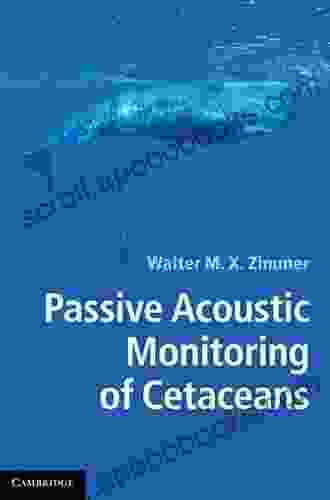Passive Acoustic Monitoring of Cetaceans: Unlocking the Secrets of the Deep

: Listening to the Symphony of the Sea
Beneath the vast expanse of the world's oceans lies a hidden realm teeming with life. Cetaceans, the enigmatic denizens of this underwater world, communicate through a symphony of clicks, whistles, and songs. These vocalizations provide a wealth of information about their behavior, ecology, and population dynamics. However, studying these elusive creatures in their natural habitat can be a daunting task.
4 out of 5
| Language | : | English |
| File size | : | 9991 KB |
| Text-to-Speech | : | Enabled |
| Screen Reader | : | Supported |
| Enhanced typesetting | : | Enabled |
| Print length | : | 367 pages |
Enter passive acoustic monitoring (PAM),a revolutionary technique that allows researchers to listen to and analyze the acoustic signals emitted by cetaceans. This non-invasive approach provides unprecedented insights into their lives, uncovering their hidden secrets and enabling us to better understand and protect these magnificent creatures.
PAM Technology: Listening Through the Waves
At the heart of PAM is an array of hydrophones, sensitive underwater microphones that capture acoustic signals from the surrounding environment. These hydrophones are deployed at strategic locations, such as in coastal waters or open ocean areas, where cetaceans are known to frequent.
Once captured, the acoustic data is processed using sophisticated algorithms that filter out background noise and identify the vocalizations produced by cetaceans. These algorithms are designed to detect specific patterns and characteristics in the acoustic signals, allowing researchers to distinguish between different species and determine their presence, abundance, and behavior.
Applications of PAM: Unraveling the Mysteries of Cetaceans
PAM has revolutionized the field of cetacean research, providing scientists with a powerful tool to study these elusive creatures. It has opened up new avenues for exploration, enabling researchers to:
- Identify species and estimate abundance: PAM allows researchers to identify different species of cetaceans based on their unique vocalizations. By analyzing the number of acoustic detections, they can estimate the abundance of each species in a particular area, providing valuable information for conservation and management.
- Monitor behavior and habitat use: The vocalizations of cetaceans provide clues about their behavior and habitat use. By analyzing the timing, frequency, and duration of acoustic signals, researchers can infer whether the animals are foraging, mating, or socializing. PAM also helps identify important habitats and migration routes, providing critical information for conservation efforts.
- Assess population health: The vocal behavior of cetaceans can reflect their overall health and well-being. Changes in vocalization patterns can indicate stress, disease, or changes in habitat quality. PAM provides a non-invasive way to monitor the health of cetacean populations and identify potential threats.
- Study communication and social interactions: Cetaceans use vocalizations to communicate with each other, establishing social bonds, coordinating group behavior, and defending territories. By analyzing acoustic signals, researchers can gain insights into the complex social dynamics of these animals and understand their communication systems.
- Detect threats and mitigate impacts: PAM can be used to detect and identify potential threats to cetaceans, such as noise pollution, habitat degradation, or ship strikes. By monitoring acoustic signals, researchers can alert authorities to hazardous events and help implement mitigation measures to protect these vulnerable animals.
Case Studies: PAM in Action
The applications of PAM have led to numerous breakthroughs in cetacean research. Here are a few notable case studies:
- In the waters of Alaska, PAM has been used to track the movements of bowhead whales, providing valuable insights into their migration routes and feeding grounds. This information has helped inform conservation strategies to protect these endangered whales.
- Off the coast of California, PAM has been used to study the vocal behavior of blue whales, the largest animals on Earth. By analyzing their songs, researchers have gained a deeper understanding of their communication patterns and social interactions.
- In the Mediterranean Sea, PAM has been used to monitor the presence and abundance of sperm whales. This information has provided critical data for conservation efforts aimed at protecting this endangered species.
: Unveiling the Secrets of the Deep
Passive acoustic monitoring has transformed the way we study cetaceans, unlocking a wealth of information about their lives, behavior, and ecology. This non-invasive technology has provided scientists with an unprecedented window into the hidden world beneath the waves, enabling us to better understand and protect these magnificent creatures.
As PAM continues to evolve, we can expect even more groundbreaking discoveries about the enigmatic world of cetaceans. This technology holds immense promise for advancing our knowledge and inspiring awe for the incredible diversity and beauty of life that thrives in the depths of our oceans.
4 out of 5
| Language | : | English |
| File size | : | 9991 KB |
| Text-to-Speech | : | Enabled |
| Screen Reader | : | Supported |
| Enhanced typesetting | : | Enabled |
| Print length | : | 367 pages |
Do you want to contribute by writing guest posts on this blog?
Please contact us and send us a resume of previous articles that you have written.
 Book
Book Novel
Novel Page
Page Chapter
Chapter Text
Text Story
Story Genre
Genre Reader
Reader Library
Library Paperback
Paperback E-book
E-book Magazine
Magazine Newspaper
Newspaper Paragraph
Paragraph Sentence
Sentence Bookmark
Bookmark Shelf
Shelf Glossary
Glossary Bibliography
Bibliography Foreword
Foreword Preface
Preface Synopsis
Synopsis Annotation
Annotation Footnote
Footnote Manuscript
Manuscript Scroll
Scroll Codex
Codex Tome
Tome Bestseller
Bestseller Classics
Classics Library card
Library card Narrative
Narrative Biography
Biography Autobiography
Autobiography Memoir
Memoir Reference
Reference Encyclopedia
Encyclopedia Jenna Mindel
Jenna Mindel Jonathan Hickman
Jonathan Hickman Kay Higuera Smith
Kay Higuera Smith Christine Davis
Christine Davis Brittney Mulliner
Brittney Mulliner Brian Moyer
Brian Moyer Brian T Kennedy
Brian T Kennedy Brian Bruya
Brian Bruya Bree Wolf
Bree Wolf Suzanne Lenhart
Suzanne Lenhart Bill Fletcher Jr
Bill Fletcher Jr Delta James
Delta James Beverley Louis
Beverley Louis Lawrence S Meyers
Lawrence S Meyers Cornelia Smith
Cornelia Smith Donnie Smith
Donnie Smith Bridget M Cook
Bridget M Cook Blair Babylon
Blair Babylon Ernest Hemingway
Ernest Hemingway Bree Kraemer
Bree Kraemer
Light bulbAdvertise smarter! Our strategic ad space ensures maximum exposure. Reserve your spot today!

 Felipe BlairOf Photographs Showing Drums The Author Made Himself: A Tale of Creativity,...
Felipe BlairOf Photographs Showing Drums The Author Made Himself: A Tale of Creativity,...
 Bryce FosterUnleash the Power of Nature in "The Storm King Novel": A Literary Masterpiece
Bryce FosterUnleash the Power of Nature in "The Storm King Novel": A Literary Masterpiece
 Harrison BlairEscape into the Heart-Pounding World of Blake Crouch's Summer Frost Forward...
Harrison BlairEscape into the Heart-Pounding World of Blake Crouch's Summer Frost Forward... Robert BrowningFollow ·19.8k
Robert BrowningFollow ·19.8k Jean BlairFollow ·14k
Jean BlairFollow ·14k Roland HayesFollow ·5.6k
Roland HayesFollow ·5.6k Evan SimmonsFollow ·18.6k
Evan SimmonsFollow ·18.6k Dan BellFollow ·3k
Dan BellFollow ·3k Nick TurnerFollow ·8.4k
Nick TurnerFollow ·8.4k Cole PowellFollow ·16.8k
Cole PowellFollow ·16.8k Leon FosterFollow ·18.7k
Leon FosterFollow ·18.7k

 Corey Green
Corey GreenHuman Geography: A Concise Introduction by Gilbert...
A Journey into the Dynamic Realm of...

 Julian Powell
Julian PowellTrain Your Mind to Make Great Art a Habit
Do you dream of...

 Matthew Ward
Matthew WardSmall Town Romance: Heart Compass
Escape to Willow Creek, Where...

 Neil Parker
Neil ParkerMusic, Social Media, and Global Mobility: Exploring...
: The Convergence of Music, Media, and...

 Seth Hayes
Seth HayesUnlock the Potential of Potential Theory with Brooke...
Embark on an...
4 out of 5
| Language | : | English |
| File size | : | 9991 KB |
| Text-to-Speech | : | Enabled |
| Screen Reader | : | Supported |
| Enhanced typesetting | : | Enabled |
| Print length | : | 367 pages |








